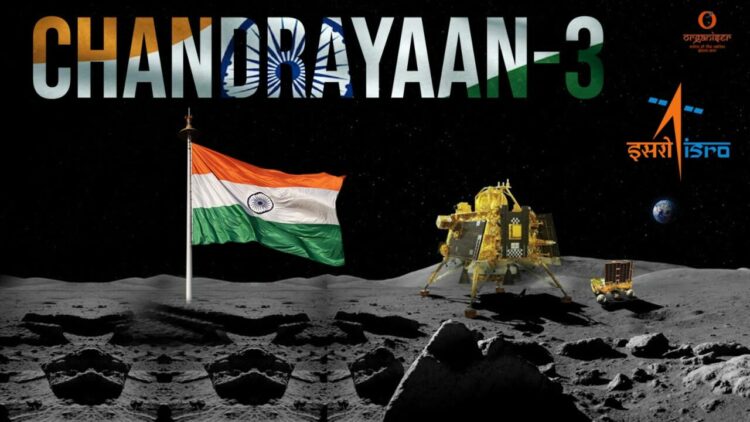On August 23, 2023, a day that will be enshrined in the memories of all Indians and India, as Bharat has accomplished a remarkable and glorious feat that even many countries of the world failed to do. It has conducted a soft landing on the surface of the moon successfully.
The Republic of India is emerging as a significant and prominent space power in the international world order. It is pioneering in space missions and space technologies and has achieved noteworthy milestones in the space sector, thus enabling the nation to join the league of advanced nations that have conducted successful space campaigns and enshrined the name of Bharat in the annals of world history.
The first man to reach the moon was Neil Armstrong. India achieved its “Armstrong status” through its first, maiden lunar mission, colloquially called the “Chandrayaan Series.” Bharat has conducted three space missions to the Earth’s natural satellite under the broader umbrella of its lunar mission campaign.
The First Mission
India’s first lunar Probe was launched by the eminent space agency of India, the Indian Space Research Organisation (ISRO). It was launched on October 22, 2008, through the PSLV-C-11 (Polar Satellite Launch Vehicle), which subsequently placed the spacecraft in a lunar orbit on November 8, 2008.
The mission provided a tremendous boost to the Indian Space Programme. The main objective of the Lunar Mission was to conduct a plethora of experiments, including the creation of a three-dimensional lunar atlas of the far and near sides of the Moon and providing high-resolution chemical and mineral imaging of the entire surface of the Moon and, above all its greatest discovery was finding water on the lunar body. More than 95 per cent of its objectives were met, and the mission was declared successful.
The Second Mission
Eleven years later, i.e., 2019, ISRO launched its second probe into space. The mission was named Chandrayaan-2. The main focus of this mission was to extensively map the moon’s surface and study in depth its variations, and then determine its origin and evolution. The most unique and special feature of this mission was to explore the south-polar region of the moon, which was not discovered by any nation to date.
The spacecraft consisted of a lunar orbiter, a lander named Vikram and a rover called Pragyan. The spacecraft and its components entered the lunar orbit on August 20, 2019, and had a limited lifespan. The lander barely had a life of fourteen days.
The second lunar mission turned into a debacle after the Vikram lander crashed during the landing on the moon’s surface. The primary cause of this is attributed to the velocity. The lander’s velocity was higher than the desired mark (two meters per second). As it crashed, the rover could not be placed on the surface of the moon.
However, the mission was not a complete failure. Nevertheless, the Large Area Soft X-ray spectrometer measured and found water signatures along with chromium and manganese for the first time with remote sensing.
Chandrayaan-3
The third lunar mission was launched on July 14, 2023, and took off at 2:35 PM. The primary objective of the third lunar mission is to conduct a soft landing on the moon. There are four scientific payloads, The rover and lander remain the same as in the last mission. They will be used for measuring lunar quakes, thermal properties, and changes in plasma. The secondary objective of the mission is to help accurately measure the distance between Earth and the Moon. There are two payloads on the rover designed to map and study the mineral composition of the Earth’s natural satellite and determine the composition of elements such as magnesium, iron and aluminium.
The Journey to the Moon
Over a month after its launch on a GSLV Mark-III heavy-lift launch vehicle from the Satish Dhawan Space Center in Sriharikota, the Chandryaan-3 mission is all set to land on the moon after an extensive period of time on August 23, 2023. The Journey after the launch is as follows:
The first orbit manoeuvre was successfully performed on July 15, 2023, Two days later, it entered into the second orbit raising manoeuvre and on July 22, 2023, the spacecraft reached its fourth lunar orbit. On August 1, 2023, the Chandrayaan-3 was inserted into the translunar orbit and entered the moon’s sphere of influence.
By August 5, 2023, the third lunar spacecraft entered the lunar orbit. A day later, it went into a planned orbit manoeuvre, which is located 170km away from the moon’s surface at its nearest point. On August 16, 2023, the lunar manoeuvres were completed, and the lander module separated itself from the Propulsion Module.
Finally, on August 23, 2023, the Chandryaan-3 spacecraft accomplished its designated task and was successful in conducting a soft landing on the moon, making Bharat the only nation in the world to have achieved this miraculous feat.














Comments